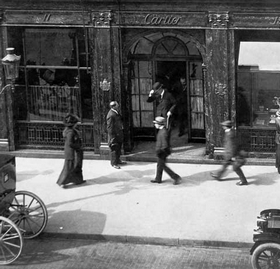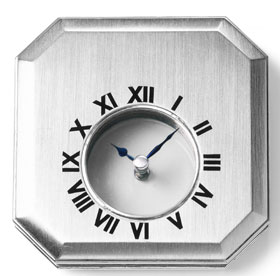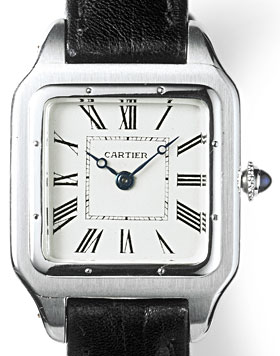

cartier
Historique de la maison d'horlogerie Cartier
En 1847, Louis-François Cartier (1819-1904) succède à son maître Adolphe Picard, dont il reprend l’atelier de bijouterie 29 rue Montorgueil à Paris. En 1853, l’atelier est transféré au 5 rue Neuve des Petits-Champs et s’ouvre à la clientèle privée. Dès 1854, on y reçoit le premier client américain.
Désireux de perpétuer la tradition dont il a hérité, Louis-François Cartier enseigne le métier à son fils Louis-François-Alfred (1841-1925). Il en fait son associé et lui confie la direction de la Maison en 1874.
À son tour, en 1898, Alfred s’associe avec son fils aîné Louis.
En 1899, Cartier s’installe à l’adresse prestigieuse du 13 rue de la Paix, centre de l’élégance et du luxe.

Dès lors, Alfred confie à ses trois fils l’avenir international de la Maison Cartier. Louis-Joseph (1875-1942) est responsable de la Maison parisienne, Pierre-Camille (1878-1964) s’installe à New York, et Jacques-Théodule (1884-1941) s’établit à Londres.
Avec Maurice Couët, maître horloger de génie, Louis Cartier développe la fabrication des pendules mystérieuses selon le principe de Robert-Houdin, inventé aux environs de 1850.
Les plus belles de ces créations, six portiques et douze chinoises, sont à Cartier ce que les Œufs de Pâques Impériaux sont à Fabergé.
Les montres-bracelets, dont les archives signalent la présence dans le stock dès 1888, connaissent un succès énorme avec la commercialisation de la montre Santos en 1911.
Le prototype de ce modèle, la première montre-bracelet sur cuir pour homme, était un cadeau, créé en 1904, destiné à l’aviateur brésilien Alberto Santos-Dumont.
Dotés de la fameuse boucle déployante brevetée en 1909, d’autres modèles suivront, conçus en collaboration avec Edmond Jaeger, qui devient un partenaire de Cartier dès 1907.
La montre Tank, dont les premiers dessins remontent à 1917, se veut un hommage aux équipages des chars alliés de la Grande Guerre. Elle sera commercialisée en 1919.
1926 Création de la montre Baguette.

Montre de poche mystérieuse Cartier Paris, 1931
Photo : Nick Welsh, Collection Cartier © Cartier
1932 Création de la montre basculante.
1936 Création de la montre Tank asymétrique.
En 1941, Jacques Cartier s’éteint à Dax, et Louis Cartier en 1942 à New York.
1950 Création de la montre Gouvernail.
1967 Création de la montre Crashwatch à Londres.
1978 Lancement de la montre Santos de Cartier or et acier.
1985 Lancement de la montre Pasha de Cartier, inspirée d’un modèle de montre étanche de 1943
En 1993, les montres à mouvement Chrono Reflex sont lancées, avec les modèles Pasha, Cougar et Diabolo de Cartier.
En 1994, Cartier fête le 90e anniversaire de la montre Santos et crée un modèle extraplat en platine et or rose, édité en série limitée : la montre Santos-Dumont.
En 1998, un hommage est rendu à la montre Santos, née en 1978 et inspirée du modèle d’origine de 1904. Elle se décline désormais dans une version avec mouvement Chrono Reflex. Cartier crée une collection de montres d’exception : la Collection Privée Cartier Paris, présentée lors du huitième Salon International de la Haute Horlogerie.
2001: Inauguration de la Manufacture de Haute Horlogerie Cartier, à la Chaux-de-Fonds (Suisse).
En 2004, Cartier lance trois nouvelles montres emblématiques, la montre Santos 100, la montre Santos-Dumont et la montre Santos Demoiselle, en hommage à la toute première montre Santos-Dumont qui fête ses 100 ans.
In 1847, Louis-François Cartier (1819-1904) took over a jewelry workshop at 29, rue Montorgueil in Paris from Adolphe Picard, the man who had taught him his trade. In 1853, Cartier moved to 5, rue Neuve des Petits-Champs, and started undertaking work for private clients. The first American client was welcomed as early as 1854.
Wishing to establish a family tradition, Louis-François Cartier taught the trade to his son, Louis-François-Alfred (1841-1925), made him a partner and handed over management of the business to him in 1874.
Alfred, in turn, made his eldest son Louis a partner in 1898. In 1899, the business took up residence in elegant and luxurious premises at the prestigious address of 13, rue de la Paix, where it was to remain for future centuries.
At last, Cartier had found a setting worthy of its aspirations. From then on, Alfred entrusted his three sons with the international management of Cartier. Louis-Joseph (1875-1942) took over responsibility for Paris, Pierre-Camille (1878-1964) went to New York and Jacques-Théodule (1884-1941) settled in London.
Together with the brilliant master clockmaker Maurice Couët, Louis Cartier began making mystery clocks based on the Robert-Houdin principle, developed around 1850.
The most beautiful of these creations were six “portiques” (portico) and twelve “chinoises” (Chimera) models : these clocks are to Cartier what imperial Easter eggs are to Fabergé.
Wristwatches, which first appeared in Cartier’s stock records in 1888, experienced enormous success with the launch of the Santos model in 1911.
The prototype was a gift to the Brazilian aviator Alberto Santos-Dumont in 1904; this was Cartier’s first-ever men’s wristwatch with a leather strap. Equipped with the famous “deployant” buckle patented in 1909, further models were to follow; these were designed with the cooperation of Edmond Jaeger, who became a partner of Cartier in 1907.

Photo : Nick Welsh, Collection Cartier © Cartier
The Tank watch, the first drawings for which date back to 1917, was designed in honor of the Allied tank crews of the First World War. It was first sold in 1919, and its harmonious form soon made it a classic.
1926 Creation of the "Baguette" watch
1932 Creation of the Basculante (pivot) watch.
1936 Creation of the asymmetrical Tank watch.
Jacques Cartier died in 1941 in Dax, France, and Louis Cartier in 1942 in New York.
1950 Creation of the Gouvernail watch.
1967, Creation of the Crash watch in London
1978 Launch of the gold and steel Santos de Cartier watch
1985 Launch of the Pasha de Cartier watch, inspired by a water-resistant model dating from 1943.
1993 saw the launch of the Chrono Reflex movement versions of the Pasha, Cougar and Diabolo de Cartier watches.
In 1994, Cartier celebrated the 90th birthday of the Santos watch and created an ultra flat model in platinum and pink gold, in a limited edition: the Santos-Dumont watch.
In 1998, the company paid homage to the Santos watch, created in 1978 and inspired by the model originally developed in 1904, with the launch of a new Chrono Reflex version.
Cartier created an exceptional collection of watches: the Collection Privée Cartier Paris, launched at the eighth Salon International de Haute Horlogerie.
2001 : Fine timepieces factory opens in La Chaux-de-Fonds, Switzerland.
In 2004, Cartier launched three new emblematic watches, the Santos 100, the Santos-Dumont and the Santos Demoiselle, as a tribute to the very first Santos-Dumont watch which celebrated its centenary.
